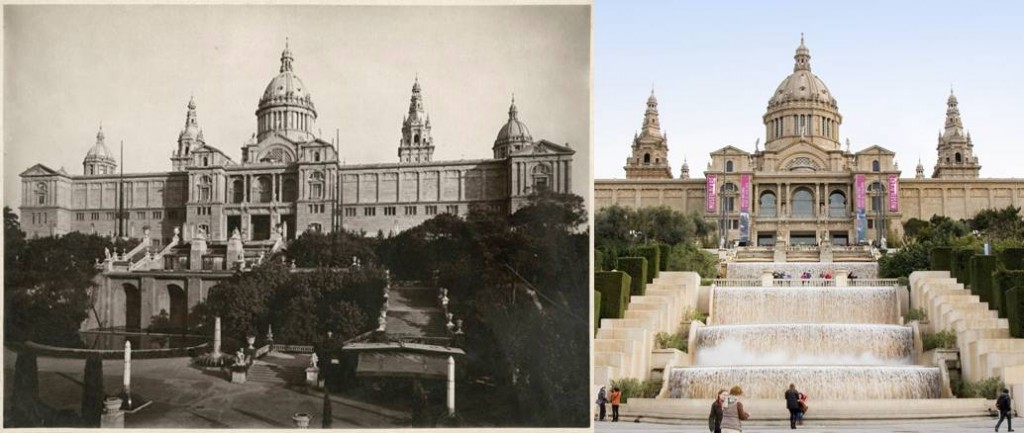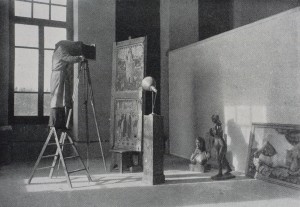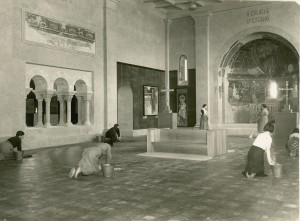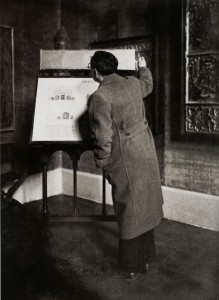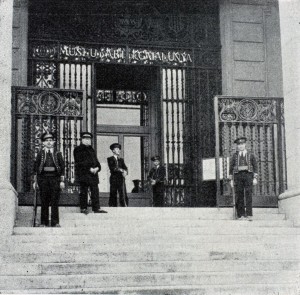Montse Gumà
We offer an illustrated tour in a jump of eighty years in the life of the museum. Flicking through the issues of September, October and November of the Butlletí dels Museus d’Art de Barcelona (The Newsletter of the Art Museum of Barcelona) of 1936, which reproduce a talk given by Joaquim Folch i Torres, the first director of the museum, from 8th December 1936, in which he makes a balance of the functioning of the museum one year after it was inaugurated, it made me want to make a nostalgic visit. Not a visit to the rooms, but to see what was hidden behind the screen, what Pere Casas Abarca qualified as the “private life” of the museum.
Nowadays we are aware that behind a museum and the collections there are hidden a whole lot of people who are working so that the users can achieve their expectations and needs, and obtain a level of satisfaction that invites them back to do another visit. This behind-the-scenes world was already a reality of the museum in the nineteen thirties and some things haven’t changed much, but the means and the techniques that we now use and follow to do this, as you can see in the images, are different ones.
Generally speaking, and without going in too deeply, as Folch i Torres says, a museum “is an institution that collects, conserves and exhibits to the public […] the works of art”. In this way, just as happens now, when a piece enters the museum, it is unpacked, it is registered with an inventory number that identifies it and a catalogue file is made as well as the identifying photograph. All this is made with the collaboration of the technical office, the help of the photographic service, the laboratory and the specialised library. What has changed? The means and resources. Nowadays all this information is organised and integrated in a collections manager (Museumplus) and a documentary manager. from where it easily becomes accessible and “exploitable”.
Unpacking of the works of art in the technical office to be filed and numbered
The photographic set in the nineteen thirties and today’s one
From the photographic laboratory and the analogical world to the digital world
From the topographical and photographic files in the register to MuseumPlus
From the reading room of the library, in the Poble Espanyol, el 1934, to the room with terminals for consultation and the WiFi connection
From the consultation of files in the technical office to the online file
And now we come to the second of the axes of the action of the museum that Folch i Torres mentioned: the conservation. We have changed the parameters and the means, but the conditions of light, temperature and humidity of the rooms were and are important. And both in the exhibition rooms as well as in the reserves, where, in the words of Folch i Torres, the conditions ensure the conservation of the works “at least as well as in the exhibition rooms”. That’s why, for example, the incidence of the light in the rooms on the upper floor is controlled by means of the covering of the skylights with the collocation of some sails that change their positions throughout the day depending on the position of the sun. Currently, in the rooms in which the work on paper is exhibited, detectors of presence have been installed.
The sails for graduating the incidence of the exterior light
From the reserves of the nineteen thirties to the current ones
In terms of the restoration, the Museu d’Art de Catalunya was a pioneer and sent the restorer, Manuel Grau i Mas, “to the centre of restorations which offered [then] the greatest guarantees from throughout Europe […], which was managed by the professor Pelliccioli in Milan” for him to learn the technique and apply it afterwards to the restorations of the museum. Nowadays, when we are confronted by the study and the integral restoration of a work, a whole lot of techniques and means help us, that allow us to keep the work stable. At the same time, they provide us with a lot of information not only about the piece in itself, such as for example the execution technique of an artist, the type of pigment that was used and where it came from, and the type of canvas or paper used, etc., but also the old restorations and other vicissitudes that it could have undergone. All this data helps us to establish criteria when starting a restoration.
The introduction of new techniques applied to restoration provide us with a lot of data that allow us to get to know the work and the artist better
As a third function of the museum, Folch i Torres talked about the exhibition. This includes diverse topics that go from the cleaning of the rooms to the labeling and the information for visitors. He considers the fact that in the same way as a director gives the work of studying to the specialists, so that of cleaning should also be given to specialists, who should have both suitable training and adequate tools or utensils for preserving the heritage.
From the cleaning with traditional techniques to “intrepid” cleaning
As exhibiting carries with it the implicit concept of informing, so a system of signage was planned in five languages which includes a short description of each of the objects exhibited in Catalan, Castilian, English, French and German. If the visitors want more information, with the inventory number, they can consult the files of the museum and buy the photograph. Currently, apart from the signs and texts of the room, parallel to this the museum has other systems that allow much more information to be given to the users: audio-guides, QR codes, apps, ibeacons, multimedia tablets etc., which invite their participation to be fostered.
From static information to interactive information
The services to the visitors didn’t end, and don’t end, here. There were guided visits, a shop where the postcards and the photographs of the pieces were sold, and the guides and the catalogues that were published, talks were given, etc. So, what has changed? The technology, the varied offer of products of merchandising adapted to the times, the system of payment by credit card and the will to place the public at the centre of attention.
The service of sales of photographs and postcards, the sale of stamps and the post office and the toilets were in the vestibule, where still today, except for the postal service, they are located
Lecture Hall of the Museu d’Art de Catalunya and one of the current auditoriums
Folch i Torres highlights a last facet: the contact with the visitors. At this point he talks to us about the service of admission tickets (there were tickets by payment, free entrance on the second Sunday of each month, and corporate tickets), a cloakroom, and a telephone for calling a car if the visitor requested it. Of all these services of visitor attention that he talks about, it seemed curious to me the existence of an “omnibus” that transported the visitors from the square of Plaça d’Espanya to the museum and vice-versa, at the price of 25 cents, a service that was not as successful as expected: it was only used by 2% of the visitors.
Foyer from the nineteen thirties and today’s
It was considered then that the number of visitors (77,030 between 1st January and 30th September 1935) was not enough to require a service of cafeteria or a restaurant, even though they had been planned. In his review behind the scenes of the museum, Folch i Torres doesn’t forget either the people who carry out the surveillance of the rooms, nor the security of the works, which is the responsibility of the fire department, or the mossos d’esquadra, the regional police, or the municipal ‘urban’ police.
After this nostalgic visit, I wonder if the social museum that we talk so much about now is in fact such a new concept. The concerns of Folch i Torres aren’t so far away from ours.
Related links
A museum more ecological and more economic: new installations in Modern Art, 2015
Building History
Projectes digitals

